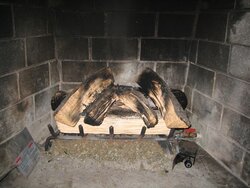So I have a gas log fireplace which was converted some time ago from a wood burning brick fireplace. During the conversion, a liner was installed inside the existing brick structure all the way to the top (2-stories). I wasn't living in the house at the time so I'm not sure if this has always been a problem but now every time I use the fireplace I get a strong exhaust smell in my house unless I keep the glass doors shut during operation. As this defeats the purpose of the fireplace for heat purposes I would rather be able to use the fireplace with the doors open. I tried lighting a couple of peices of newspaper and watched the smoke. For the most part it looks like the smoke goes up the chimney but I did see some roll back of smoke towards the front of the fireplace. I have a feeling that the fireplace is not drawing properly. Does anyone have any ideas how I can correct this? I do have an access panel about 8 feet up the chimney. Would it be possible to vent somehow from there instead of requiring the exhaust to travel up two stories?
I also tried moving the log set back in the fireplace but that didn't seem to make much difference either. Also, I did have the flu open!
Any ideas would be greatly appreciated!
I also tried moving the log set back in the fireplace but that didn't seem to make much difference either. Also, I did have the flu open!
Any ideas would be greatly appreciated!


